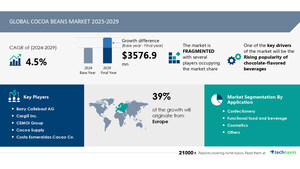NEW YORK, Aug. 23, 2024 /PRNewswire/ -- The global silk market size is estimated to grow by USD 5.00 billion from 2024-2028, according to Technavio. The market is estimated to grow at a CAGR of almost 9.24% during the forecast period. Increasing requirement for silk in textile industry is driving market growth, with a trend towards increasing r and d on spider silk. However, health hazards during silkworm rearing poses a challenge. Key market players include AMSilk GmbH, Anhui Silk, Bolt Threads, Camenzind and Co. AG, Eastern Silk Industries Ltd., Eris Global, Jinchengjiang Xinxing Cocoon Silk Co. Ltd., Kraig Biocraft Laboratories Inc., Libas Ltd., Ongetta srl, Qingdao Textiles Group Fiber Technology Co. Ltd., WENSLI, Wujiang First Textile Co. Ltd., Xuzhou Shengkun Silk Manufacturing Co. Ltd., and Zhejiang Jiaxin Silk Corp. Ltd..
Get a detailed analysis on regions, market segments, customer landscape, and companies- View the snapshot of this report
Silk Market Scope |
|
Report Coverage |
Details |
Base year |
2023 |
Historic period |
2018 - 2022 |
Forecast period |
2024-2028 |
Growth momentum & CAGR |
Accelerate at a CAGR of 9.24% |
Market growth 2024-2028 |
USD 5001.8 million |
Market structure |
Fragmented |
YoY growth 2022-2023 (%) |
8.25 |
Regional analysis |
APAC, Europe, North America, South America, and Middle East and Africa |
Performing market contribution |
APAC at 64% |
Key countries |
China, India, US, Italy, and France |
Key companies profiled |
AMSilk GmbH, Anhui Silk, Bolt Threads, Camenzind and Co. AG, Eastern Silk Industries Ltd., Eris Global, Jinchengjiang Xinxing Cocoon Silk Co. Ltd., Kraig Biocraft Laboratories Inc., Libas Ltd., Ongetta srl, Qingdao Textiles Group Fiber Technology Co. Ltd., WENSLI, Wujiang First Textile Co. Ltd., Xuzhou Shengkun Silk Manufacturing Co. Ltd., and Zhejiang Jiaxin Silk Corp. Ltd. |
Market Driver
Spider silk, a natural fiber with exceptional strength, resilience, and flexibility, is the focus of intensive research and development due to its remarkable toughness. Kraig Biocraft Laboratories has made strides in this field, acquiring exclusive rights to patented genetic sequences for silk proteins. This advancement holds great potential for producing ballistics-resistant materials that are lighter, thinner, and more flexible than steel. The global silk market is expected to grow significantly as a result of increased research activities in this area. Spider silk's unique properties make it an ideal candidate for creating life-saving materials in various industries.
The silk sector is experiencing a surge in trends, with Sundresses being a popular choice for fashion-forward consumers. Silk production continues to grow, driven by demand for seri-by-products like Dipeptides and Tripeptides used in the pharmaceutical, nutraceutical, and cosmetics industries. The silk protein market is expanding, with applications in textiles, surgical sutures, and personal care. Sericulture, the process of raising Silk Worms, is key to cocoon production. Reeling, throwing, weaving, and dyeing transform raw silk into textile. Silk material prices vary based on type, including Mulberry silk, Tussar silk, Eri silk, and Spider silk. Transportation options are crucial for efficient distribution, from Silk comforters to Parachutes. The silk industry also includes seri-waste products and amino acids, contributing to the bloodstream and dermis skin layer. Overall, the silk sector offers diverse opportunities in textiles, medicine, and beyond.
Explore a 360° Analysis of the Market: Unveil the Impact of AI. For complete insights- Request Sample!
Market Challenges
- The sericulture industry, a labor-intensive sector, faces significant health risks for its workforce. Reproductive and menstrual factors linked to endometrial cancer have been identified in women workers. Occupational hazards include handling diseased silkworms and their excreta, as well as exposure to formalin, bleaching powder, and chromium for disinfection and dye fixation. These factors can lead to skin irritation, ulcers, sensitization, and allergies. Consequently, these health risks may hinder the growth of the global silk market during the forecast period.
- The Silk Market encompasses various types of silk, including Mulberry, Tussar, Eri, and Spider silk. Challenges in this industry include the cultivation of Silk Worms for Sericulture, which relies on the Mulberry leaf for food. The production of Cocoons is crucial, followed by Reeling, Throwing, Weaving, and Dyeing to create Textiles. Silk fibroin and silk polypeptide are valuable proteins used in Cosmetics and Medicine. Silk's natural properties, like its absorbent nature, conductive properties, comfort, softness, and elegance, make it an expensive material for Textile Application. However, it requires careful handling as Dry Cleaning is recommended, and Sun Exposure and Water Exposure can damage it. Silk's versatility extends to various applications, such as Summer clothing, Bicycle Tires, and Household items like Pillows, Upholstery, and Draperies. Silk's luxurious appeal is showcased in Gowns, Wedding gowns, Neckties, Scarves, and Haute couture garments, including Formal dress suits, Robes, and Kimonos.
For more insights on driver and challenges - Request a sample report!
Segment Overview
This silk market report extensively covers market segmentation by
- Type
- 1.1 Mulberry
- 1.2 Tussar
- 1.3 Eri
- Application
- 2.1 Textile
- 2.2 Cosmetics
- 2.3 Medicine
- Geography
- 3.1 APAC
- 3.2 Europe
- 3.3 North America
- 3.4 South America
- 3.5 Middle East and Africa
1.1 Mulberry- The Silk Market in Beijing is a renowned shopping destination, famous for its authentic Chinese goods. Here, you can find a vast array of items, from traditional clothing and accessories to souvenirs and local delicacies. Merchants sell high-quality silk products at competitive prices. The market's central location and convenient hours make it an attractive destination for both locals and tourists. Visitors can haggle for the best deals, ensuring a satisfying shopping experience.
For more information on market segmentation with geographical analysis including forecast (2024-2028) and historic data (2017-2021) - Download a Sample Report
Research Analysis
Silk is a natural fiber derived from the cocoons of silkworms, spiders, and other insects. The most commonly produced silk is obtained from the silkworm, which goes through the process of sericulture. Different types of silk include Mulberry silk, Tussar silk, and Eri silk, each with unique characteristics. Silk fibroin and silk polypeptide are the main proteins found in silk. Cocoon production begins with the reeling process, where the silk threads are extracted from the cocoons. The threads are then thrown, or unwound, and prepared for weaving and dyeing. Silk is used in various industries, from cosmetics and fashion to medicine. Natural fiber is used to create elegant gowns, wedding gowns, neckties, scarves, and household items such as wall hangings, pillows, upholstery, draperies, ties, shirts, and more. Silk-based biomaterials have also gained popularity in recent years, with applications in protein fiber and advanced medical uses. Silk's unique properties, including its strength, flexibility, and luster, make it a highly sought-after material for various industries and applications.
Market Research Overview
Silk Market: A Global Overview The silk market is a thriving industry that encompasses the production and utilization of various types of silk, including Mulberry silk, Tussar silk, Eri silk, and Spider silk. This natural fiber, derived from the cocoons of Silkworms, is renowned for its absorbent nature, conductive properties, comfort, softness, elegance, and textile application. Silk fibroin and silk polypeptide are the primary components of silk, making it a valuable protein fiber. Cocoon production involves the reeling, throwing, weaving, and dyeing process to create textiles. Silk's expensive material status is attributed to its limited production, with demand coming from various sectors like cosmetics, medicine, and textiles. Applications of silk extend beyond textiles, including bicycle tires, summer clothing, and household items like pillows, upholstery, and wall hangings. In the medical field, silk is used for surgical sutures and in nutraceuticals. Silk's absorbent nature and conductive properties make it suitable for use in personal care and pharmaceutical industries. Silk's versatility is evident in its diverse applications, from gowns and wedding gowns to neckties, scarves, and haute couture garments. The silk sector also generates seri-by-products and seri-waste products, contributing to the silk protein market and the production of dipeptides and tripeptides. Silk material prices are influenced by various factors, including transportation options, seasonal demand, and production costs. Proper handling is crucial to prevent damage from sun exposure, water exposure, and dry cleaning. The silk industry continues to evolve, with ongoing research and development in the field of sericulture and silk production.
Table of Contents:
1 Executive Summary
2 Market Landscape
3 Market Sizing
4 Historic Market Size
5 Five Forces Analysis
6 Market Segmentation
- Type
- Mulberry
- Tussar
- Eri
- Application
- Textile
- Cosmetics
- Medicine
- Geography
- APAC
- Europe
- North America
- South America
- Middle East And Africa
7 Customer Landscape
8 Geographic Landscape
9 Drivers, Challenges, and Trends
10 Company Landscape
11 Company Analysis
12 Appendix
About Technavio
Technavio is a leading global technology research and advisory company. Their research and analysis focuses on emerging market trends and provides actionable insights to help businesses identify market opportunities and develop effective strategies to optimize their market positions.
With over 500 specialized analysts, Technavio's report library consists of more than 17,000 reports and counting, covering 800 technologies, spanning across 50 countries. Their client base consists of enterprises of all sizes, including more than 100 Fortune 500 companies. This growing client base relies on Technavio's comprehensive coverage, extensive research, and actionable market insights to identify opportunities in existing and potential markets and assess their competitive positions within changing market scenarios.
Contacts
Technavio Research
Jesse Maida
Media & Marketing Executive
US: +1 844 364 1100
UK: +44 203 893 3200
Email: [email protected]
Website: www.technavio.com/
SOURCE Technavio

WANT YOUR COMPANY'S NEWS FEATURED ON PRNEWSWIRE.COM?
Newsrooms &
Influencers
Digital Media
Outlets
Journalists
Opted In




Share this article